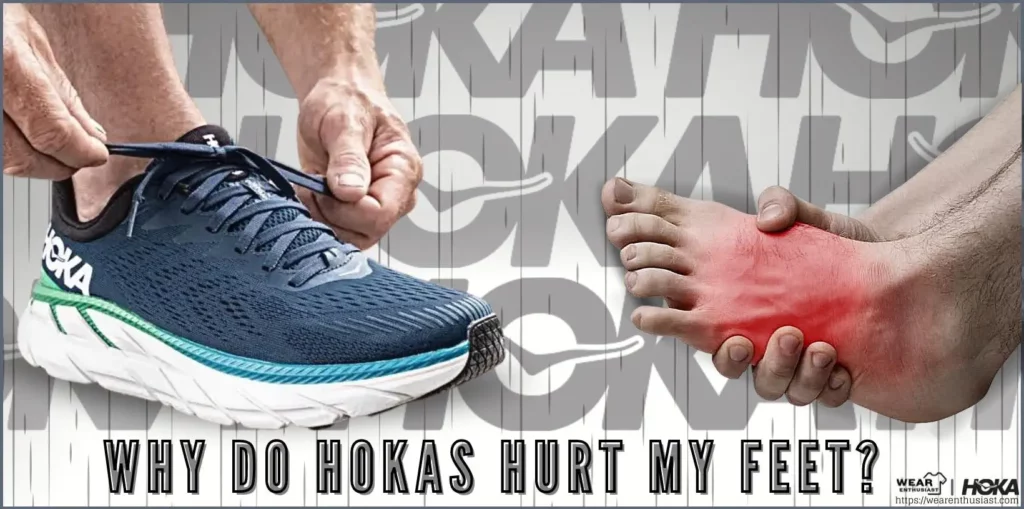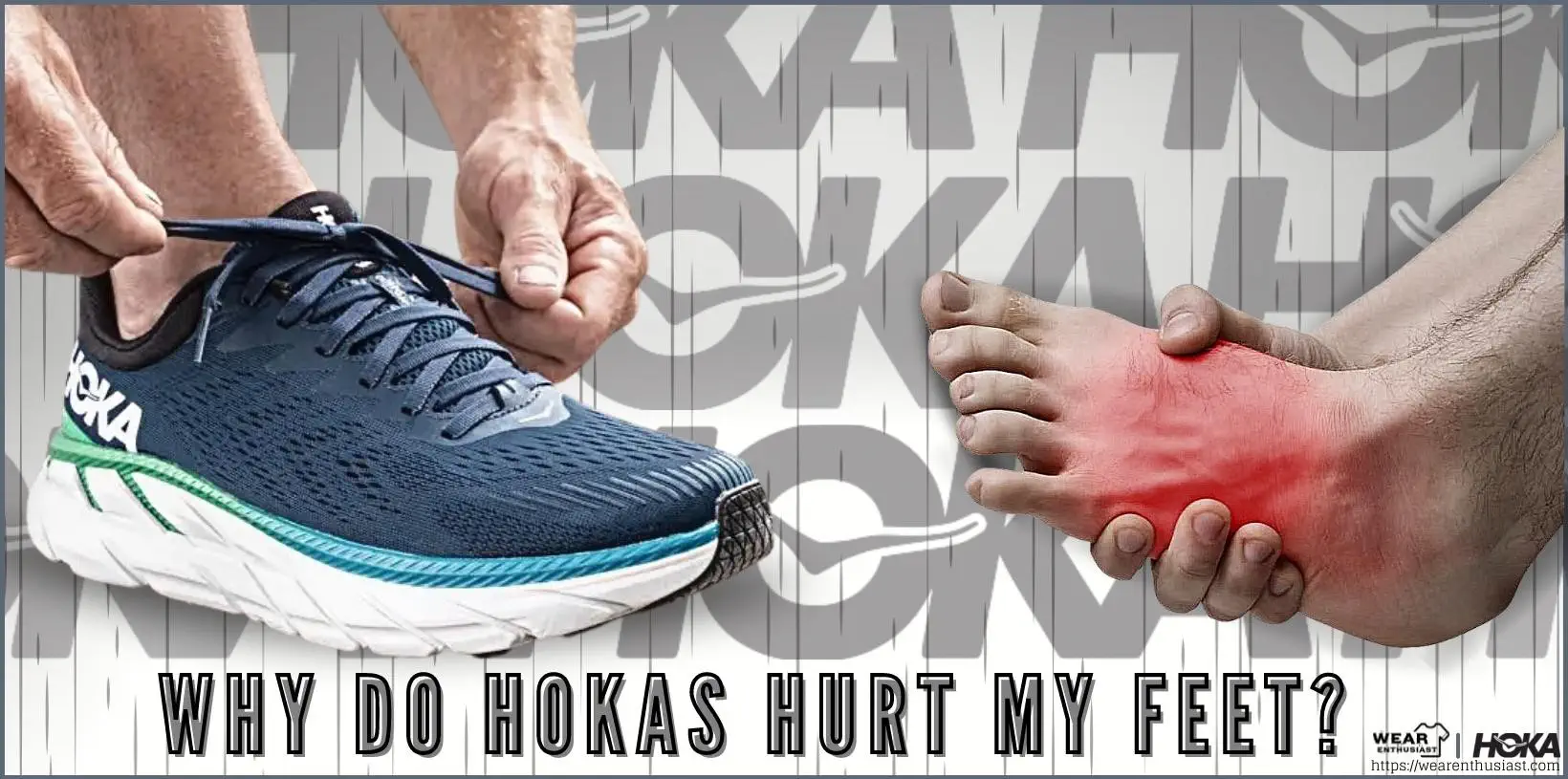
A lot of people love the comfort and support that HOKAs provide. They are designed to provide more cushioning and support than traditional running shoes, and many people find them to be very comfortable.
But, people are often confused about why their feet hurt in HOKA shoes because they seem to be so cushioned and supportive. While the cause of the pain may vary from person to person, there are a few potential reasons why HOKAs might hurt your feet.
This post explores some possible reasons why you could experience foot pain while wearing HOKAs and what you can do to alleviate the pain.
➤ The Reasons Why Do HOKAs Hurt My Feet
HOKA shoes are top listed for their comfort, but if you’re experiencing foot pain, it could be due to one of the following reasons:
✦ Thick Cushioning
HOKAs’ thick cushioning actually puts more pressure on your feet than it relieves. This is because this type of cushioning prevents your feet from sinking into the shoes as much, which can lead to discomfort.
The thicker cushioning also allows your feet to slide around more inside the shoes, causing blisters. Plus, the added weight of the cushioning can make your feet feel tired more quickly.
✦ Forced Bounce
The thick cushioning in HOKAs can also create a ‘forced bounce’ effect, where the shoes are constantly pushing your feet back up. This can lead to pain in the balls of your feet, as well as Achilles tendon pain.
It happens in feet pain in HOKAs because of the design of their soles. The soles are very thick and stiff, which doesn’t allow your feet to flex as you walk or run. This can cause a lot of stress on the tendons and muscles in your feet and lower legs, leading to pain.
✦ Lake of Arch
HOKAs generally have poor arch support, which can lead to discomfort in the feet, ankles, and knees. As a result, your feet are not being properly supported, and they are having to work harder to keep you stable.
With their poor arch support, your feet can also start to overpronate (roll inward), which puts even more stress on the knees and ankles.
✦ Too Supportive
Due to their thick cushioning and stiff soles, HOKAs can actually be too supportive for some people. This can cause the muscles in your feet to weaken over time, as they are not being used as much.
As a result, there is a possibility that you will experience foot pain when you start to wear HOKAs because your feet are not used to the level of support they provide.
✦ Tight Toe Box
The toe box in HOKAs is often very tight, which can cause pain in the toes and bunions. Due to this, your toes are being squeezed together, and they aren’t able to move freely.
Normally, your toes should have enough space to spread out and grip the ground when you walk or run. But, in HOKAs, they are often restricted, which can lead to pain.
✦ Fitting Issues
HOKAs are designed to fit snugly, but if they are too tight, they can cause pain in the feet. Because of this, your feet will be constricted and won’t be able to move properly.
Your feet need to be able to move and flex naturally when you walk or run, and if they are restricted by tight shoes, it can lead to pain.
These are some of the reasons you might experience foot pain when wearing HOKAs. If you’re experiencing pain in your feet when wearing Hokas, it’s important to figure out the cause so you can treat it properly.
➤ How to Prevent HOKAs from Hurting Feet?
Blisters are a common problem when wearing new shoes, but they can also be a problem with shoes that you have been wearing for a while. One type of shoe that is especially prone to causing blisters is the HOKAs. There are several things that you can do to prevent this from happening.
First, reduce the friction between your feet and the shoes by wearing socks or using toe protectors. You can also insert shoe pads or insoles to help prevent abrasion in areas such as your heels. Finally, you can apply paper tape to areas that are prone to blistering.
By taking these steps, you can help prevent HOKAs from hurting your feet.
➤ How Long Do HOKAs Take to Break In?
While many runners enjoy the brand’s shoes, some may wonder how long it takes to break them in. HOKAs shoes typically need to be broken in for two to three weeks.
The break-in process may take longer for some models. After wearing the shoes for a month, they should feel ideal. Otherwise, you may be wearing the wrong shoes. Running shoes should be comfortable and supportive so that you can enjoy your runs.
➤ Is HOKAs Good for Plantar Fasciitis?
The HOKA is a great choice if you have plantar fasciitis and are looking for a shoe that will help. While still firm enough to provide support, the thick stack of foam absorbs impact well. Walking or running in the shoe is made more comfortable by its wide base.
As a result, plantar fascia stress can be reduced, resulting in a reduction in pain. Whether you’re experiencing symptoms of plantar fasciitis for the first time or have been dealing with them for a long time, HOKA shoes can definitely help.
But remember, just because a shoe is good for plantar fasciitis, it doesn’t mean it will work for everyone. Make sure to try on a few different pairs of shoes to see what feels best for you.
Conclusion
Having learned why Hokas could be painful for your feet and how to fix the problem, you can enjoy walking and running in your shoes pain-free. Running and walking are great activities to do with Hokas.
They offer a lot of cushioning and support, which can help reduce pain in the feet, ankles, and knees. However, they do have some potential drawbacks that can lead to pain. To get further assistance, try to follow the tips above. For further assistance, you can visit a doctor or podiatrist.

